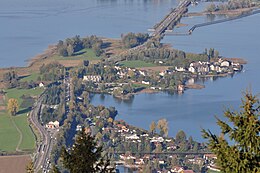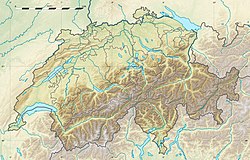Freienbach–Hurden Rosshorn
| UNESCO World Heritage Site | |
|---|---|
 The site of the prehistoric settlement | |
| Location | Hurden, Freienbach, Canton of Schwyz, Switzerland |
| Part of | Prehistoric Pile Dwellings around the Alps |
| Criteria | Cultural: (iv), (v) |
| Reference | 1363-027 |
| Inscription | 2011 (35th Session) |
| Area | 4.32 ha (10.7 acres) |
| Buffer zone | 20.1 ha (50 acres) |
| Website | www |
| Coordinates | 47°13′10.38″N 8°48′24.61″E / 47.2195500°N 8.8068361°ECoordinates: 47°13′10.38″N 8°48′24.61″E / 47.2195500°N 8.8068361°E |
 Location of Freienbach–Hurden Rosshorn in Canton of Schwyz | |
Freienbach–Hurden Rosshorn is one of the 111 serial sites of the UNESCO World Heritage Site Prehistoric pile dwellings around the Alps, of which are 56 located in Switzerland.[1][2]
Geography[]
The site is located on Zürichsee lakeshore in Hurden, a locality of the municipality of Freienbach in the Canton of Schwyz in Switzerland. Situated at the Seedamm, an isthmus between the Zürichsee and the Obersee lake area, it was in close vicinity to the prehistoric lake crossings, neighbored by three other Prehistoric pile dwelling settlements: Freienbach–Hurden Rosshorn, Freienbach–Hurden Seefeld, Rapperswil-Jona/Hombrechtikon–Feldbach and Rapperswil-Jona–Technikum. Because the lake has grown in size over time, the original piles are now around 4 metres (13 ft) to 7 metres (23 ft) under the water level of 406 metres (1,332 ft). The settlement comprises 4.32 hectares (10.67 acres), and the buffer zone including the lake area comprises 20.10 hectares (49.67 acres) in all.
Description[]
Freienbach–Hurden Rosshorn provides early evidence of transport routes combined with special metal finds interpreted as sacrificial offerings. The site includes several lake crossings beginning in the Horgen culture. Several Early Bronze Age construction phases have been identified, as well as remains from the Hallstatt culture and Roman era providing dendrochronological dates about periods from which no other sites are known.[3]
Protection[]
As well as being part of the 56 Swiss sites of the UNESCO World Heritage Site Prehistoric pile dwellings around the Alps, the settlement is also listed in the Swiss inventory of cultural property of national and regional significance as a Class A object of national importance.[4] Hence, the area is provided as a historical site under federal protection, within the meaning of the Swiss Federal Act on the nature and cultural heritage (German: Bundesgesetz über den Natur- und Heimatschutz NHG) of 1 July 1966. Unauthorised researching and purposeful gathering of findings represent a criminal offense according to Art. 24.[5]
See also[]
Literature[]
- Peter J. Suter, Helmut Schlichtherle et al.: Pfahlbauten – Palafittes – Palafitte. Palafittes, Biel 2009. ISBN 978-3-906140-84-1.
- Beat Eberschweiler: Ur- und frühgeschichtliche Verkehrswege über den Zürichsee: Erste Ergebnisse aus den Taucharchäologischen Untersuchungen beim Seedamm. In: Mitteilungen des Historischen Vereins des Kantons Schwyz, Volume 96, Schwyz 2004.[6]
References[]
- ^ "Prehistoric Pile Dwellings in Switzerland". Swiss Coordination Group UNESCO Palafittes (palafittes.org). Archived from the original on 2014-10-07. Retrieved 2014-12-07.
- ^ "World Heritage". palafittes.org. Archived from the original on 2014-12-09. Retrieved 2014-12-08.
- ^ "Sites Switzerland: Freienbach–Hurden Rosshorn (CH-SZ-01)". palafittes.org. Archived from the original on 2014-10-07. Retrieved 2014-12-08.
- ^ "A-Objekte KGS-Inventar (Kanton Schwyz)" (PDF). Schweizerische Eidgenossenschaft, Amt für Bevölkerungsschutz. 2015-01-01. Archived from the original (PDF) on 2015-06-17. Retrieved 2015-09-14.
- ^ "Bundesgesetz über den Natur- und Heimatschutz (NHG)" (PDF) (in German). Hochbaudepartement Stadt Zürich. 2014-10-12. Retrieved 2015-08-21.
- ^ Beat Eberschweiler (2004). "Ur- und frühgeschichtliche Verkehrswege über den Zürichsee: Erste Ergebnisse aus den Taucharchäologischen Untersuchungen beim Seedamm" (in German). ETH Bibliothek. Retrieved 2014-12-08.
External links[]
| Wikimedia Commons has media related to Freienbach–Hurden Rosshorn. |
- Prehistoric pile dwellings in Switzerland
- Freienbach
- Lake Zurich
- Cultural property of national significance in the canton of Schwyz
- Archaeological sites in Switzerland




